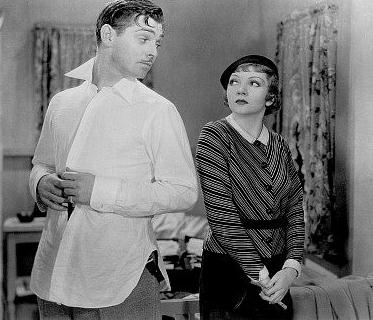Claim: Sales of men's undershirts declined sharply after actor Clark Gable appeared bare-chested in the 1934 film It Happened One Night.

Examples:
[Wooten, 1995]
Gable's most vital contribution to my carefree charm came five years before his trademark role - and
Gable, in what was then considered a racy scene with Claudette Colbert, took his shirt off to reveal a bare chest. America gasped: Where is his undershirt?
In AMC's "The Hollywood Fashion Machine," host Jacqueline Bisset recalls the impact of that disrobing: "The underwear industry was literally paralyzed."
Geoffrey Beene adds: "When Gable, in that famous scene, took off his shirt and he had no undershirt on, he suddenly made all sorts of men realize, 'Why do I have to wear an undershirt if Clark Gable doesn't wear an undershirt?' "
Freed from the unneeded garment that bound them, American men found one-shirt-at-a-time happiness.
[Gottschalk, 1995]
[W]hat's not on the screen can have as much impact as what is. In 1934, after Clark Gable undressed for bed in ''It Happened One Night,'' sales of men's undershirts dropped
Origins: The tale about Clark Gable and the demise of the men's undershirt industry is another example of how easily a piece of information can become an accepted "fact" whose validity is never questioned despite any real evidence that it is indeed true.
After Clark Gable removed his shirt to reveal a bare chest in a famous scene with Claudette Colbert in the 1934 film It Happened One Night, American men abandoned the wearing of undershirts in droves, so much so that undershirt sales declined by 75%, undergarment manufacturers were "devastated," and the industry didn't recover until the requirements of World
First off, what documentation supports the claim that "sales of men's undershirts dropped
Another factor to consider is that even if undershirt sales did drop dramatically after 1934, how would we know this decline was directly attributable to the image of a bare-chested Clark Gable?
In any case, how can we account for a single film's having such a profound impact upon the ingrained dressing habits of American males? A 75% drop in sales would mean that a shirtless Clark Gable had to have influenced (directly or indirectly) far more than just the usual group of young urbanites who form the target audience typically receptive to fads. Young and old, city dwellers
and country folk, rich and poor: All of them would had to have been just waiting for an excuse to shuck that second shirt in 1934, a huge percentage of American men tired of wearing
Proponents of the It Happened One Night claim make the mistake of equating new clothing fads with the shedding of existing patterns of dress. Sure, popular entertainments have long had an influence on fashion, but that influence generally affects only a small part of the population (i.e., the generations not yet old enough to be set in their ways) and involves the wearing of new styles of existing clothing (such as shorter skirts) or previously uncommon articles of apparel (such as capes or floppy hats), not the sudden casting off of long-worn functional articles of clothing. Women didn't abandon brassieres after seeing Clark Gable romance a braless Jean Harlow in 1932's Red Dust, and men didn't stop wearing "outershirts" after Marlon Brando popularized the leather jacket and white
Perhaps rather than looking for a cause-and-effect relationship here, we should regard the decline in undershirt-wearing (if one did indeed occur) as yet another instance of a common phenomenon: Popular figures who reflect shifts in societal norms come to be seen as the causative agents who brought those shifts about, even though they were already well underway. Men had started to give up on wearing hats before
Last updated: 10 May 2014
Sources: |
Gottschalk, Mary. "AMC's Look at Hollywood Fashion Follows Fads from Screen to Closet." Pittsburgh Post-Gazette . 17 August 1995 (p. C1). Steinberg, Neil. "Bowing to a Fashion God." Chicago Sun-Times. 25 April 2000 (p. 44). Washington, Roxanne. "How the Movies Inspired High Fashion." The [Cleveland] Plain-Dealer. 17 August 1995 (p. E6). Wooten, Frank. "Frankly, My Dear, I Hate Undershirts." The [Charleston] Post and Courier. 18 August 1995 (TV; p. 4).
;
 Also told in:
Also told in:Segaloff, Nat. The Everything Tall Tales, Legends, & Outrageous Lies Book. Holbrook, MA: Adams Media Corp., 2001. ISBN 1-58062-514-2 (p. 153).
